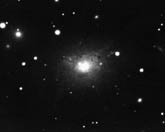The Hidden Lives of Galaxies - How Galaxies Get Their Names
 |
|
Seyfert Galaxy NGC 1275 in Perseus |
Later, astronomers added other classifications. One of these astronomers was Carl Seyfert. In 1943, he discovered galaxies with very bright central regions. Seyfert studied the spectra of these galaxies. The spectra indicated that the central region was bright at all wavelengths. This indicated some enhanced activity, and "Seyfert" galaxies became the first of a range of active galaxies that have been studied at all wavelengths since then.
B. How Galaxies Get Their Names
Catalogues are used to list galaxies. One of the earliest catalogues of objects in the sky was made by Charles Messier, who denoted objects by using the letter "M." Messier, a comet-hunter in the 1700s, kept finding galaxies and nebulae in the sky because many of them looked like comets. Eventually, he created a catalogue of these objects, listing their positions so he wouldn't be fooled again into thinking they were comets. Although he categorized many brilliant objects in the night sky, his cataloguing system was completed in a random manner.
Another common cataloguing system is the NGC (New General Catalogue) which dates from the 19th century. The NGC numbers objects from west to east across the sky. All objects in the same area of the sky have similar NGC numbers. Several other cataloguing systems are: ESO (European Southern Observatory), IR (Infrared Astronomical Satellite), Mrk (Markarian), and UGC (Uppsala General Catalog). The numbers following the letter designation may indicate either the order in the list or the location of the galaxy in the sky. Some galaxies are given descriptive names (e.g. "Andromeda", "Whirlpool") if they are particularly distinctive in location or appearance.

